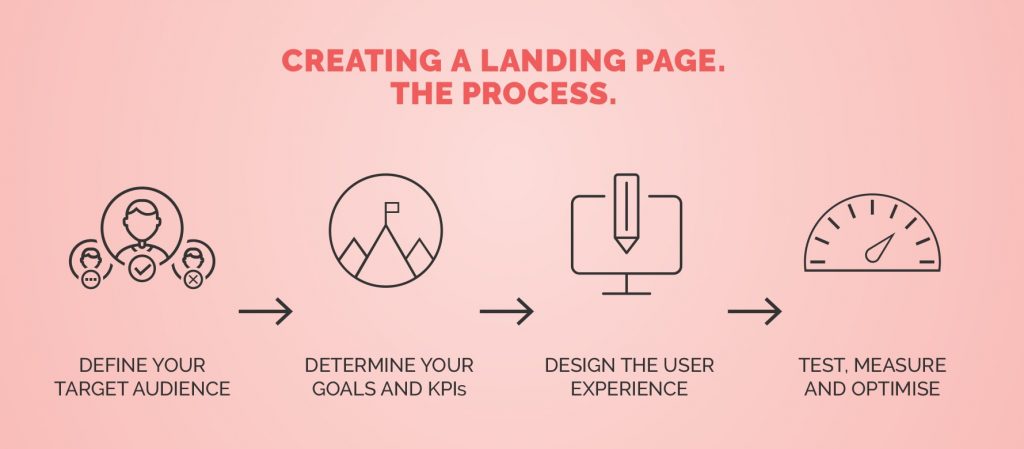75% of financial marketers say that their primary goal for creating content is lead generation so having an effective destination for web traffic is more important than ever. Being able to capture the details of your site visitors is a key step in ensuring that they can be moved down the purchase funnel towards a sale.
To do this effectively, digital campaigns should use a dedicated landing page. But what exactly is a landing page and how is it different from any other page on your website?
Dedicated destinations to drive data
A landing page is a standalone page designed for one purpose: conversion. This could be to opt-in for an eBook, webinar registration, or even sign-up for an account. Landing pages use persuasive elements like benefit-orientated copy, social proof and scarcity messages to encourage visitors to take action.
As a destination for your digital activity, an effective landing page can make a huge difference to the effectiveness of lead generation efforts. With many elements contributing to the overall effectiveness, even small changes, when combined, can lead to a great outcome. Consider this – an increase in conversion from 2% to 3% is actually a 50% increase in the number of leads that a campaign generates – incremental increases can make a huge difference.
In this article, we’ll look at 5 ways to ensure that your landing pages are optimised to deliver results.

1. Ensure each landing page is tightly targeted to a defined market or offer
It can be tempting to try to appeal to every potential customer for your product or service. However, landing pages that target a specific audience profile are significantly more successful generic versions.
Example: a fixed Income fund may know that its two key markets are:
- Families who are looking for regular and predictable income that allows them to plan for known upcoming expenses e.g. school fees.
- Retirees who prioritise capital protection over growth.
Thinking about these two audiences, it seems clear that each has distinct needs. Creating landing pages for audiences with targeted messaging and imagery will resonate with each persona, building a better connection and resulting in higher conversion rates.
2. Match the outcome to their stage of the buying cycle
It’s essential to ensure that the function and call to action on your landing page is aligned with the audience’s stage in its purchase lifecycle.
Example: a wealth management firm may have two landing pages, each targeted at prospects at different stages of their buying journey:
- Landing Page A could offer an opt-in for an educational eBook, which explains how a managed fund could be part of a diversified investment portfolio. This would deliver value for someone researching the topic in the early stages of their investment journey.
- Landing Page B could offer a calculator for prospects to enter their portfolio details and receive a free call back from an Adviser.
These two landing pages have very different purposes and are suited to prospects at different stages of their investing journey. However, both could be used as part of the same inbound campaign, with leads from landing page A nurtured and qualified towards landing page B.
3. Use proven UX
The design and development of landing pages has matured over the last 5 years. Constant testing and improvements have resulted in a set of principles that have been proven to work effectively and deliver high conversions.
These principles include:
- Benefit-led, rather than feature-led messaging.
- Social proof through testimonials.
- A clear call to action message, compelling site visitors to take action.
- One call to action per landing page. If people are given a choice, they often choose ‘no choice’.
- Outcome-led messaging on call to action buttons e.g. ‘Get the 10 top tips’ rather than just ‘sign up’.
- Distraction-free design: no top navigation menu or social media links, to ensure that potential sign-ups aren’t lost.
Your landing page has the best chance of delivering a high conversion rate, by starting with best practice and benefitting from the learning of others.
4. Optimise constantly
Constantly testing and optimising your page is the key to ensuring that your landing page delivers high rates of conversions.
A/B testing different versions of the landing page and retaining the higher performing version can mean that small improvements are compounded into large gains over time.
For example, the optimisation process for a car insurance comparison landing page could be:
- Testing headline copy – a ‘peace of mind’ benefit-led message against a harder ‘Save 10%’ headline. The more effective benefit-led headline outperforms the conversion rate by 0.4%, an increase from 2% to 2.4%, or 20% more leads.
- Comparing the effectiveness of two banner images – showing an aspirational lifestyle image of a family enjoying using their car delivers 10% more engagement than an image a man using a computer to find an insurance quote, increasing the conversions further from 2.4% to 2.64%.
- Changing the call to action – button to ‘Find out how much you could save’ delivers a 20% increase over a generic ‘Get a quote’ message, increasing the leads from 2.64% to 3.168%.
As you can see, by making kaizen-like improvements to the design and copy, significant cumulative improvements can be made to conversion rates, leads and ultimately sales.
5. Make it easy for you
While in the past creating, testing and optimising a landing page was an involved task. Now, a swathe of tools now means that this process can be handled almost entirely by marketers.
While designers and developers may need to be involved with the initial set-up of a landing page, a well-designed WordPress landing page template, or the use of a landing page tool such as Leadpages, can mean that a new landing page can be set up in minutes.
This agility and flexibility is key to ensuring that you have the control to easily create, test and modify landing pages, delivering outstanding results.
See how Yell used best practice landing page tactics and continuous optimisation to increase Australian Stock Report’s leads by 78%, while reducing the cost per lead by 38%.








